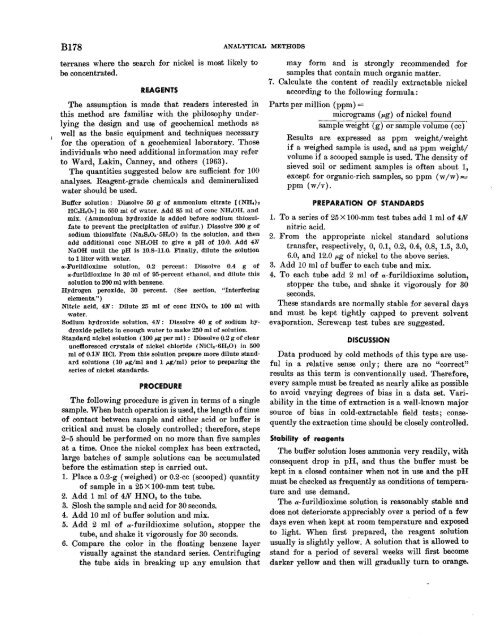RESEARCH· ·1970·
RESEARCH· ·1970·
RESEARCH· ·1970·
Create successful ePaper yourself
Turn your PDF publications into a flip-book with our unique Google optimized e-Paper software.
B178<br />
terranes where the search for nickel is most likely to<br />
be concentrated.<br />
REAGENTS<br />
The assumption is made that readers interested in<br />
this method are familiar with the philosophy underlying<br />
the design and use of geochemical methods as<br />
well as the basic equipment and techniques necessary<br />
for the operation of a geochemical laboratory. Those<br />
individuals who need additional information may refer<br />
to Ward, Lakin, Canney, and others (1963).<br />
The quantities suggested below are sufficient for 100<br />
analyses. Reagent-grade chemicals and demineralized<br />
water should be used.<br />
Buffer solution: Dissolve 50 g of ammonium citrate [ (NH,)ll<br />
HC6HG07] in 550 ml of water. Add 85 ml of cone NH40H, and<br />
mix. (Ammonium hydroxide is added before sodium thiosul·<br />
·fate to prevent the precipitation of sulfur.) Dissolve 200 g of<br />
sodium thiosulfate (Na2S203·5H20) in the solution, and then<br />
add additional cone NH10H to give a pH of 10.0. Add 4N<br />
NaOH until the pH is 10.8-11.0. Finally, dilute the solution<br />
to !liter with water.<br />
a-Furildioxime solution, 0.2 percent: Dissolve 0.4 g of<br />
a-furildioxime in 30 ml of 95-percent ethanol, and dilute this<br />
solution to 200 ml with benzene.<br />
Hydrogen peroxide, 30 percent. (See section, "Interfering<br />
elements.")<br />
Nitric acid, 4N: Dilute 25 ml of cone HN03 to 100 ml with<br />
water.<br />
Sodium hydroxide solution, 4N: Dissolve 40 g of sodium hydroxide<br />
pellets in enough water to make 250 ml of solution.<br />
Standard nickel solution (100 pg per ml) : Dissolve 0.2 g of clear<br />
unetHoresced crystals of nickel cllloride (NiCl2·6H20) in 500<br />
ml of O.lN HCI. From this solution prepare more dilute standard<br />
solutions (10 ,ug/ml and 1 ,ug/ml) prior to preparing the<br />
series of nickel standards.<br />
PROCEDURE<br />
The following procedure is given in terms of a single<br />
sample. When batch operation is used, the length of time<br />
of contact ·between sample and either acid or buffer is<br />
critical and must be closely controlled; therefore, steps<br />
. 2-5 should be performed on no more than five samples<br />
at a time. Once the nickel complex has been extracted,<br />
large batches of sample solutions can be accumulated<br />
before the estimation step is carried out.<br />
1. Place a 0.2-g (weighed) or 0.2-cc (scooped) quantity<br />
of sample in a 25 X 100-mm test tube.<br />
2. Add 1 ml ·of 4N HN0 3 to the tube.<br />
3. Slosh the sample and acid for 30 seconds.<br />
4. Add 10 ml of buffer solution and mix.<br />
5. Add 2 ml of a-furildioxime solution, stopper the<br />
tube, and shake it vigorously for 30 seconds.<br />
6. Compare . the color in the floating benzene layer<br />
visually against the standard series. Centrifuging<br />
the tube aids in breaking up any emulsion that<br />
ANALYTICAL METHODS<br />
may form and is strongly recommended for<br />
samples that contain much organic matter.<br />
7. Calculate the content of readily extractable nickel<br />
according to the following formula :<br />
Parts per million (ppm) =<br />
micrograms (p.g) of nickel found<br />
sample weight (g) or sample volume (cc)<br />
Results are expressed as ppm weight/weight<br />
if a weighed sample is used, and as ppm weight/<br />
volume if a scooped sample is used. The density of<br />
sieved soil or sediment samples is often about 1,<br />
except for organic-rich samples, so ppm (w/w)~<br />
ppm (w/v).<br />
PREPARATION OF STANDARDS<br />
1. To a series of 25 X 100-mm test tubes add 1 inl of 4N<br />
nitric acid.<br />
2. From the appropriate nickel standard solutions<br />
transfer, respectively, 0, 0.1, 0.2, 0.4, 0.8, 1.5, 3.0,<br />
6.0, and 12.0 p.g of nickel to the above series.<br />
3. Add 10 ml of buffer to each tube and mix.<br />
4. To each tube add 2 ml of a-furildioxime solution,<br />
stopPer the tube, and shake it vigorously for 30<br />
seconds.<br />
These standards are normally stable for several days<br />
and must be kept tightly capped to prevent solvent<br />
evaporation. Screwcap test tubes are suggested.<br />
DISCUSSION<br />
Data produced by cold methods of this type are useful<br />
in a relative sense only; there are no "correct"<br />
results as this term is conventionally used. Therefore,<br />
every sample must be treated as nearly alike as possible<br />
to a void varying degrees of bias in a data set. V ariability<br />
in the time of extraction is a well-known major<br />
source of bias in cold-extractable field tests; consequently<br />
the extraction time should be closely controlled.<br />
Stability of :reagents<br />
The buffer solution loses ammonia very readily, with<br />
consequent drop in pH, and thus the buffer must be<br />
kept in a closed container when not in use and the pH<br />
must be checked as frequently as conditions of temperature<br />
and use demand.<br />
The a-furildioxime solution is reasonably stable and<br />
does not deteriorate appreciably over a period of a few<br />
days even when kept at room temperature and exposed<br />
to light. When first prepared, the reagent solution<br />
usually is slightly yellow. A solution that is allowed to<br />
stand for a period of several weeks will first become<br />
darker yellow and then will gradually turn to orange.
















